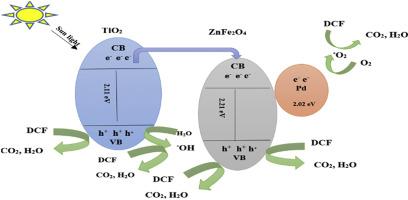Journal of Environmental Management ( IF 8.7 ) Pub Date : 2020-06-29 , DOI: 10.1016/j.jenvman.2020.110964 Najmeh Ahmadpour 1 , Mohammad Hossein Sayadi 1 , Sara Sobhani 2 , Mahmood Hajiani 1

|
In the last decades, the use of magnetic nanocomposites as a catalyst was considered for removal of organic pollutants due to its easy separation. Therefore, initially, TiO2@ZnFe2O4/Pd nanocomposite was prepared and then used in the photodegradation of diclofenac under direct solar irradiation in the batch and continuous systems. The structure, morphology and other specifications of produced nanocatalyst were determined via XRD, VSM, FESEM/EDX, FTIR, GTA, UV–Vis, Zeta potential, XPS and ICP-OES. The effective factors on diclofenac removal via nanophotocatalyst viz. pH, catalyst concentration, initial concentration of diclofenac, and flow rate and column length on diclofenac photodegradation were studied. Based on the results, the optimal rate for pH, catalyst concentration, and initial concentration of diclofenac was 4, 0.03 g/l and 10 mg/l respectively. Pd-coated TiO2@ZnFe2O4 magnetic photocatalyst had higher photocatalytic activity in diclofenac photodegradation in relation to ZnFe2O4 and TiO2@ZnFe2O4 under solar light irradiation. The findings showed that after five recycles, the photocatalytic efficiency did not show much reduction i.e. the removal efficiency from 86.1% in the first cycle reduced only to 71.38% in the last cycle. Likewise, in this study, with flow rate reduction and column length increase diclofenac degradation rate increased.
中文翻译:

新型磁性TiO2 @ ZnFe2O4 / Pd纳米复合材料对模型药物污染物的光催化降解,具有增强的光催化活性和日光稳定性。
在过去的几十年中,由于磁性纳米复合材料易于分离,因此被认为可以去除有机污染物。因此,最初,TiO 2 @ZnFe 2 O 4制备了/ Pd纳米复合材料,然后将其用于间歇和连续系统中在直接日光照射下双氯芬酸的光降解。通过XRD,VSM,FESEM / EDX,FTIR,GTA,UV-Vis,Zeta电位,XPS和ICP-OES确定了所生产纳米催化剂的结构,形态和其他规格。通过纳米光催化剂去除双氯芬酸的有效因素。研究了pH,催化剂浓度,双氯芬酸的初始浓度,流速和柱长对双氯芬酸光降解的影响。根据结果,双氯芬酸的最佳pH值,催化剂浓度和初始浓度分别为4、0.03 g / l和10 mg / l。钯涂层TiO 2 @ZnFe 2 O 4磁性光催化剂在日光照射下与ZnFe 2 O 4和TiO 2 @ZnFe 2 O 4相比,在双氯芬酸光降解中具有较高的光催化活性。研究结果表明,经过5次循环后,光催化效率并未降低太多,即去除效率从第一个循环的86.1%降低到最后一个循环的71.38%。同样,在本研究中,随着流速的降低和色谱柱长度的增加,双氯芬酸的降解速率也随之提高。



























 京公网安备 11010802027423号
京公网安备 11010802027423号